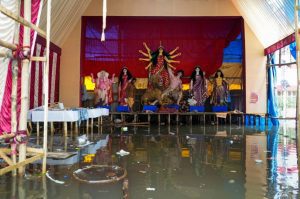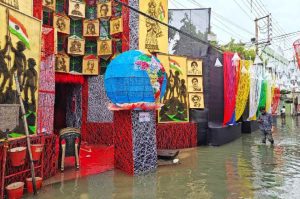Kolkata Durga Puja 2025 — In a dramatic challenge to the city’s festive spirit, the September 23 deluge brought heavy rainfall and flooding that severely affected several Durga Puja pandals across Kolkata. Organisers have been scrambling to repair damaged structures, restore decorations, and ensure visitor safety, even as crowds surge to experience the city’s most anticipated festival.
The deluge, one of the heaviest rainfall events in recent years, has not only tested the resilience of pandal structures but also highlighted the importance of disaster preparedness and crowd management during large-scale cultural events.

The Immediate Impact of the Deluge
The heavy rains caused widespread waterlogging in multiple areas, particularly low-lying zones like Chetla Agrani, Deshapriya Park, Kumartuli Park, and Bhowanipore.
- Structural Damage: Several pandals suffered damage to platforms, flooring, and temporary scaffolding. Sections of wooden walkways collapsed under waterlogged conditions, and decorative elements, including intricate sculptures and chandeliers, were compromised.


- Electrical Hazards: Electrical systems, including lighting and sound equipment, were affected by water ingress, creating potential safety risks for both visitors and staff.
- Submerged Decorations: Many thematic decorations were submerged or damaged, requiring urgent restoration to maintain the visual appeal that pandals are known for.
🔗 For general guidelines on urban flood preparedness, see the Central Water Commission – Urban Flood Management Guidelines.
Organisers’ Rapid Response
Pandals’ management teams have been working tirelessly to mitigate damage and restore safe conditions:
- Water Removal and Ground Restoration: Pumps and drainage systems have been deployed to remove stagnant water. Wooden walkways and temporary flooring are being reconstructed to prevent slips and falls.
- Electrical Repairs: Licensed electricians are inspecting and repairing electrical wiring, lighting installations, and sound systems to ensure safety compliance.
- Replacement of Damaged Decor: Sculptors and artisans are repairing or replacing decorations, including thematic backdrops, idols, and lighting fixtures, to ensure the festival’s aesthetic standards are maintained.
- Safety Checks: Fire tenders and municipal authorities are conducting inspections to certify that pandals meet safety requirements before reopening to the public.
🔗 For official guidelines on public safety at large gatherings, refer to the National Disaster Management Authority – Crowd Safety and Emergency Protocols.
Kolkata Durga Puja 2025: Managing the Crowd Surge
Despite the adverse weather, visitors have flocked in large numbers, eager to participate in the festival. Organisers are implementing crowd management measures, including:
- Regulated entry points with ticketing and volunteer assistance
- Barricades and designated pathways to ensure orderly movement
- Coordination with Kolkata Police for traffic diversion and emergency access
- Deployment of volunteers for assisting elderly and differently-abled visitors


The Durga Puja festival, one of Kolkata’s most celebrated cultural events, attracts thousands daily. The enthusiasm of visitors, even amid challenging conditions, underscores the festival’s central role in Kolkata’s cultural identity.
High-Risk Areas and Preventive Measures
The deluge has highlighted the need for proactive disaster preparedness for festival organisers:
- Structural Reinforcement: Pandals in flood-prone areas are being retrofitted with stronger scaffolding and waterproof flooring.
- Drainage Planning: Temporary channels and pumps are being installed around pandals to prevent future waterlogging.
- Emergency Coordination: Organisers are coordinating with Kolkata Municipal Corporation (KMC) and fire services for rapid response to any incidents.
- Weather Monitoring: Organisers are actively monitoring IMD forecasts to prepare for potential rainfall and flooding during the remaining days of the festival.
🔗 For real-time weather updates and alerts, see the India Meteorological Department – Kolkata Weather.
Community and Public Reactions
- Many local residents and festival-goers expressed admiration for the organisers’ swift restoration efforts.
- Some visitors voiced concerns about safety, crowd density, and access to emergency exits, emphasizing the need for structured crowd control.
- Social media has been abuzz with images and videos showing resilient volunteers, rapid repairs, and the spirit of celebration despite adverse weather.
This dual narrative of concern and celebration illustrates the community’s commitment to preserving cultural heritage while prioritising safety.
Economic and Cultural Implications
The floods affected vendors, artisans, and local businesses dependent on the festival:
- Artisans and Sculptors: Many lost materials or faced delays in delivering thematic elements and idols.
- Food and Merchandise Vendors: Stalls were damaged or had to close temporarily, impacting revenue.
- Tourism and Hospitality: Hotels and local transport services experienced changes in bookings due to waterlogging and traffic diversions.
Despite these challenges, organisers remain optimistic, aiming to restore normalcy quickly and preserve the festival’s economic and cultural impact.
🔗 For guidelines on small business disaster management, refer to the Ministry of Micro, Small & Medium Enterprises – Disaster Resilience Programs.
Lessons Learned and Future Planning
The September 23 deluge has prompted organisers to reassess disaster preparedness protocols:
- Advance Risk Assessment: Mapping flood-prone zones and designing pandals accordingly.
- Infrastructure Resilience: Investing in modular and waterproof structures for temporary installations.
- Coordination with Authorities: Strengthening collaboration with KMC, Kolkata Police, fire services, and disaster management teams.
- Emergency Drills: Training volunteers and staff for evacuation and first-aid response.
- Visitor Awareness: Encouraging festival-goers to follow safety guidelines and report hazards promptly.
These measures aim to make the Durga Puja festival both safe and accessible, even in extreme weather conditions.
Conclusion
The September 23 deluge posed an unprecedented challenge to Kolkata’s Durga Puja celebrations. Organisers, artisans, volunteers, and municipal authorities have demonstrated resilience and rapid action to restore pandals, manage crowds, and safeguard visitors.
This episode serves as a critical case study for urban festival management, emphasizing the importance of:
- Integrating disaster preparedness into cultural events
- Ensuring structural and electrical safety
- Maintaining community engagement and crowd control
- Balancing cultural celebration with public safety
As the festival progresses, Kolkata’s experience provides valuable lessons for other cities hosting large-scale events in areas prone to adverse weather, reinforcing the need for planning, resilience, and community collaboration.
🔗 For official updates on disaster management and flood preparedness, refer to the West Bengal Disaster Management & Civil Defence Department.

